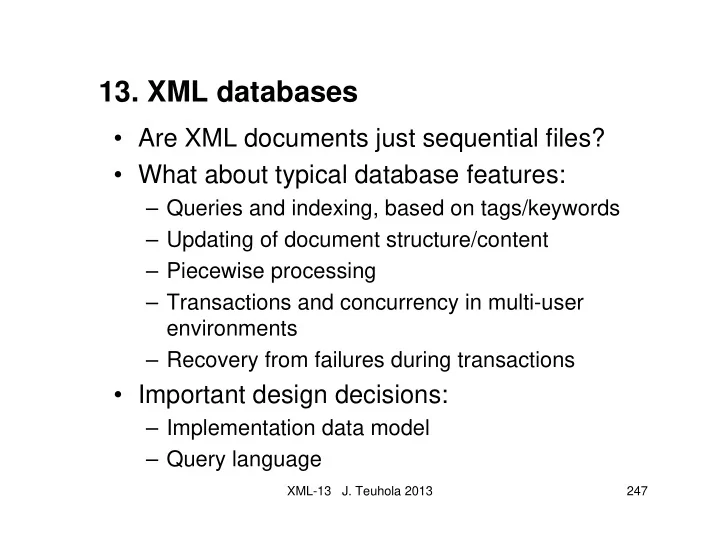

13. XML databases • Are XML documents just sequential files? • What about typical database features: – Queries and indexing, based on tags/keywords – Updating of document structure/content – Piecewise processing – Transactions and concurrency in multi-user environments – Recovery from failures during transactions • Important design decisions: – Implementation data model – Query language XML-13 J. Teuhola 2013 247
Implementation alternatives for XML databases 1. Relational database ; alternatives for storage: Document as a field, seq. processing & extensions – Non-typed DOM implementation; DOM-tree pre- – sented using parent-child relations Typed DOM impl.; a relation for each node type – 2. Object-oriented database More direct mapping of DOM model to OO concepts – Both typed and non-typed implementations possible; – non-typed more flexible 3. Native XML database Database schema based on DTD or XML schema – Support for hierarchical structures – XML-13 J. Teuhola 2013 248
Example document collection: 2 courses <?xml version=“1.0”?> <?xml version=“1.0”?> <course> <course> <cname>Adv DB</cname> <cname>C++</cname> <teacher>Timo</teacher> <teacher>Esa</teacher> <audience> <audience> <student>Pasi</student> <student>Pasi</student> <student>Pirjo</student> <student>Pia</student> </audience> </audience> </course> </course> XML-13 J. Teuhola 2013 249
Relational alternative 1: XML data type for a column Courses-relation cid course document c1 <?xml…?><course><cname>AdvDB</cname><teacher> Timo</teacher><audience><student>Pasi</student> <student>Pirjo</student></audience></course> c2 <?xml version=“1.0”?><course><cname>C++</cname> <teacher>Esa</teacher><audience> <student>Pasi </student><student>Pia</student></audience></course> XML-13 J. Teuhola 2013 250
Relational alternative 2: Non-typed nodes Nodes-relation node-id element parent text-value n1 course - - n2 cname n1 Adv DB n3 teacher n1 Timo n4 audience n1 - n5 student n4 Pasi n6 student n4 Pirjo n7 course - - n8 cname n7 C++ … … … … XML-13 J. Teuhola 2013 251
Relational alternative 3: Typed nodes Courses cid cname teacher c1 Adv DB Timo c2 C++ Esa Note 1: In each solution, Audience the DTD or XML schema student cid must be stored separately. Pasi c1 Pirjo c1 Note 2: The solution uses Pasi c2 the information that cname Pia c2 and teacher are 1-valued. XML-13 J. Teuhola 2013 252
Query languages for XML • Query goals: – Retrieve documents satisfying a selection condition. – Retrieve subparts of a document on the basis of a selection condition. • Conditions can be structural (based on node relationships) or content-based (based on text). • Several propositions have been made for XML query languages. • XPath is a popular choice, and also a basis for more advanced languages. • XQuery 1.0 : – W3C recommendation (Jan 2007) – Returns the answer in XML form XML-13 J. Teuhola 2013 253
XQuery design goals • Declarative syntax, with two alternatives – Human-readable syntax (cf. SQL) – XML syntax (called XQueryX) • Ability to create and transform XML trees (cf. XSLT) for output • Combining information from multiple documents • Support for namespaces • Support for simple and complex data types • Utilization of XML Schema information XML-13 J. Teuhola 2013 254
XQuery vs. XPath • XQuery 1.0 is a superset of XPath 2.0; every XPath expression is a legitimate XQuery expression (exception: only axes child, des- cendant, parent, attribute, self and descendant- or-self are required to be implemented) • Extensions over XPath: – Ability to join information from different sources – Ability to generate new XML structures – User-defined functions – Arbitrary computations XML-13 J. Teuhola 2013 255
XQuery vs. XSLT • Both can be used for extracting, combining and transforming XML data. • Same processing power • Different design principles and origins: XQuery inspired by SQL; XSLT by CSS. • Strengths of XSLT: – Recursive traversals and arbitrary-depth processing – Efficient implementations • Strengths of XQuery: – Simpler for simple tasks – Less verbose XML-13 J. Teuhola 2013 256
‘Prolog’ definitions in XQuery queries • Version declaration (“xquery version 1.0”) • Handling of boundary whitespace (e.g. “declare boundary-space preserve”) • Namespace definition (e.g. “declare namespace ns = …”) • Importing a schema from a URI (“import schema at …”) • Declaring variables with initial values (declare variable $name = …;) XML-13 J. Teuhola 2013 257
XQuery expressions • Atomic expressions: – primitive types integer, boolean, string, etc. – simple constructor functions for types, imported from schemas, e.g. xs:string(“Adv DB”), xs:date(“2006-10-12”) • XML expressions for new elements, attributes, character data, … can be constructed • Enclosed expressions, syntax: { expression } The expression result will be positioned into the context where it occurs. XML-13 J. Teuhola 2013 258
XQuery expressions: Example • FLWOR expressions ( for – let – where – order by – return ), e.g. <large-courses> { for $c in fn:doc(“courses.xml”)//course let $s := $c/audience/student where fn:count($s) gt 4 return <large> { $c/name/text() } </large> } </large-courses> XML-13 J. Teuhola 2013 259
XQuery expressions: Example (cont.) Source document: <?xml version="1.0" <student>Paavo</student> encoding="UTF-8"?> <student>Pirjo</student> <courses> <student>Pekka</student> <course> <student>Pirkko</student> <name>Adv DB</name> <student>Pauli</student> <audience> </audience> <student>Pekka</student> </course> <student>Paula</student> </courses </audience> </course> Result of the previous query: <course> <large-courses> <name>C++<name> <large>C++</large> <audience> </large-courses> XML-13 J. Teuhola 2013 260
XML support in some commercial DBMSs • IBM DB2 9 ‘Viper’: – Hybrid relational/XML database management system – Storage alternatives: • XML collection (decomposed storage, composed output) • CLOB (Character Large OBject) columns • XML columns & indexes – SQL and XQuery support for both normal and XML columns • Oracle 11g XML DB: – Storage alternatives: Object-relational, CLOB, binary – Support for XQuery • Microsoft SQL Server 2005: – Storage alternatives: • XML-type columns • Decomposed storage (‘shredding’); composing for output – Support for (subset of) XQuery and XML-DML XML-13 J. Teuhola 2013 261
Some ’native’ XML databases • dbXML – Open-source (dbXML Group; SourceForge) – XPath is the main query language • eXist – Open-source (project led by Wolfgang Meier) – Support for XPath, XQuery, XUpdate • xDB – Commercial (EMC corp.) – Support for XPath, XQuery, XUpdate – See: https://community.emc.com/community/edn/xmltech XML-13 J. Teuhola 2013 262
Recommend
More recommend